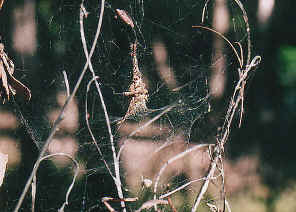Russian Tent Spider -Cyrtophora parnasia
FAMILY ARANEIDAE
This page contains pictures and information about Russian Tent Spiders that we found in the Brisbane area, Queensland, Australia.
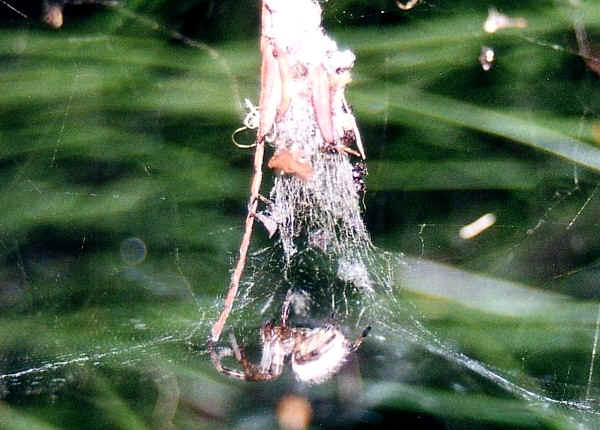
- Leg to leg 12mm
This Russian Tent Spider has been living on the pine tree in our backyard for a while. She made her eggs sac so she must be a female. Let's call her Mrs. Tent. During the daytime she hides in her web hub, which she uses as eggs sac too. She sits upside down below the hub waiting for prey every night. Unlike the Garden Web Spiders who re-builds new webs every night, Mrs. Tent, like every other Tent Spider, re-builds their tents only very occasionally. She will try to repair her tent if it was not damaged very much.
Let's become familiar with the construction of the Russian Tent Web.
There are some major differences between the tent webs and the normal orb webs. First the tent webs are horizontal while most orb webs are vertical. Secondly all silks on the tent webs are not sticky, in most of the orb webs the capture spirals are sticky and are more elasticity. In comparing with the tent web and the orb web, the orb web seems to have a better efficiency in capturing prey. For the tent web, the main web is always surrounded by the tangled thread. The tangled thread is believed to absorb the first impact of prey so that they can be captured in the main web. The third difference is, on the tent web each cell of the web is always a square. All sides of the cell are in equal length. But in orb web cell is rectangle in shape. The width is longer and longer when looking from center to outside.


One evening I saw Mrs. Tent start to remove the messy thread of her
existing tent. I knew that she was going to build a new one. A Russian Tent
Spider building tent is rarely seen. I cancelled all my activities that night,
set up the cameras and lighting and watch how she built the tent.
After Mrs. Tent cleaned up the old messy thread, she just threw
the silk under her web site. The Garden Orb Web Spider will eat and recycle the
silk but Mrs. Tent did not do that.
We can see a white little ball near the bottom of the photos is the old
silk. All the old thread was removed except the centre hub and some supporting
frame threads at the outside surrounding. When doing the cleaning, she sometimes
went forwards and backwards in her site. I guess Mrs. Tent was laying down some
new frame threads and anchor points. Mrs. Tent took about 30 minutes to clean up
her site.

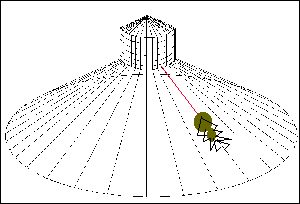
Then Mrs. Tent start to put the radii threads from the hub to the outside frame threads. She walked around her hub and check. If there is a gap, she will add a radius. Then she might check the other side of the hub and add some other radii, until she found no gaps.


Then Mrs. Tent will start to lay the spiral threads. Unlike most orb web
spider, Tent Spiders will not lay the auxiliary spiral and the sticky capture
spiral. Mrs. Tent will lay only one layer of spiral threads, which although is
not sticky, is the capture spiral.
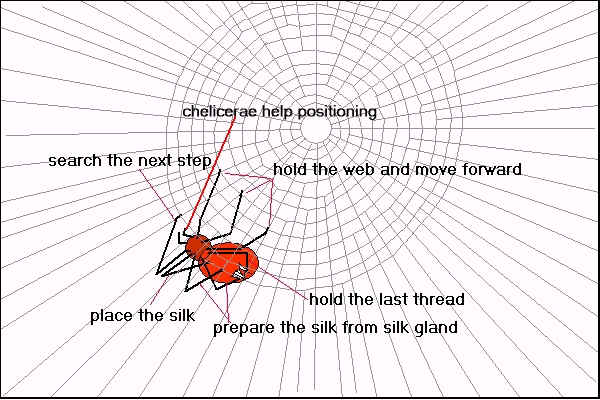
When laying anti-clockwise, she used the left three legs, L1, L2 and L3
for holding herself and moving forwards. She used the last left leg L4 to hold
the last silk she just laid. She used the last three right legs R2, R3 and R4 to
put the new step silk on. She used the front right leg R1 to search for the next
step. She may used her pedipalps for guiding and positioning as well. Mrs. Tent
took about 0.5 second to lay one step for the spiral threads.
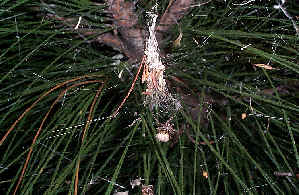

Mrs. Tent will try to keep each cell more or less a square. Once she
finds that the gap becomes too large, she will add another radii thread at that point
to the outside frame. On laying the spiral thread, Mrs. Tent will some times
make a U-turn. I do not know why and when she does this.
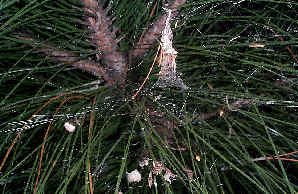

Another different with normal orb web is, there are clean cut of different stages in building normal orb web. Garden Orb Web Spider will put frame, then radii, then auxiliary spiral, and then capture spiral. Every step is clean. And in one stage, Garden Orb Web Spider will only do one thing until the stage is finish. But Mr. Tent just put on any things she wanted, she might lay the spiral thread, or radii thread, or even put another anchor point.


By keep on laying the spiral threads and radii threads in this way, after a whole night, Mrs. Tent finished the whole main web. In the end of her web building, Mrs. Tent will added more anchor points to her web. During building the web, from time to time, she might go back to the centre and pull the web in different directions with all her legs. I think she was checking the tension of her web.


In the final stage, Mrs. Tent put some more tangled threads on the top
and bottom of her web. It took her more that 12 hours to rebuild her web. During
building, she might take a few minutes rest inside her hub. When all was done,
the sun just starts to shine on the web. Now was the time Mrs. Tent to take a
good sleep in her newly built web.
Now we know how tent web is built. The next question is : How spiders learn to build their web? See more in our Discussions.
One thing about the tent web we noticed is, for both Tent Spider's and Russian Tent Spider's webs, beside they are non- sticky, they are water proof. The water drop will not attached to the web silks. Their web will not be affected even under heavy rain. I try will a garden water hose, with a column of water spray towards the tent web. The tent webs are not affected, not a single drop of water leave in the web and no any damage can be found, just like nothing has happened. I do the same test with the orb web build by Garden Orb-web Spider and their web is slightly damage, with a lot of water drip left on the web and some of the web silk stick together. I guess the tent web silk has a special effect on the water surface tension. There could be some applications for human if we find out this secret.
Orb-web attached a lot of water drops after raining but Tent Spider's webs are not affected.
- Reference:
- 1. Cyrtophora parnasia - The Find-a-spider Guide for Australian Spiders, University of Southern Queensland, 2007.
[ Up ] [ Garden Orb Web Spider ] [ Sliver Lobed Spider ] [ Brown Lobed Spider ] [ Scorpion-tailed Spider ] [ Leaf Nesting Spider ] [ Bush Orb Weaver ] [ Triangular Spider ] [ Triangular Spider II ] [ Tent Spider ] [ Russian Tent Spider ] [ Pan-web Spider ] [ St Andrew's Cross Spider ] [ Banded Orb-weaving Spider ] [ Gumtree Trunk Weaver ] [ Two-spined Spider ] [ Bird-dropping Spider ] [ Jewel Spider ] [ Wrap-around Spider ] [ Tree-stump Spider ]


